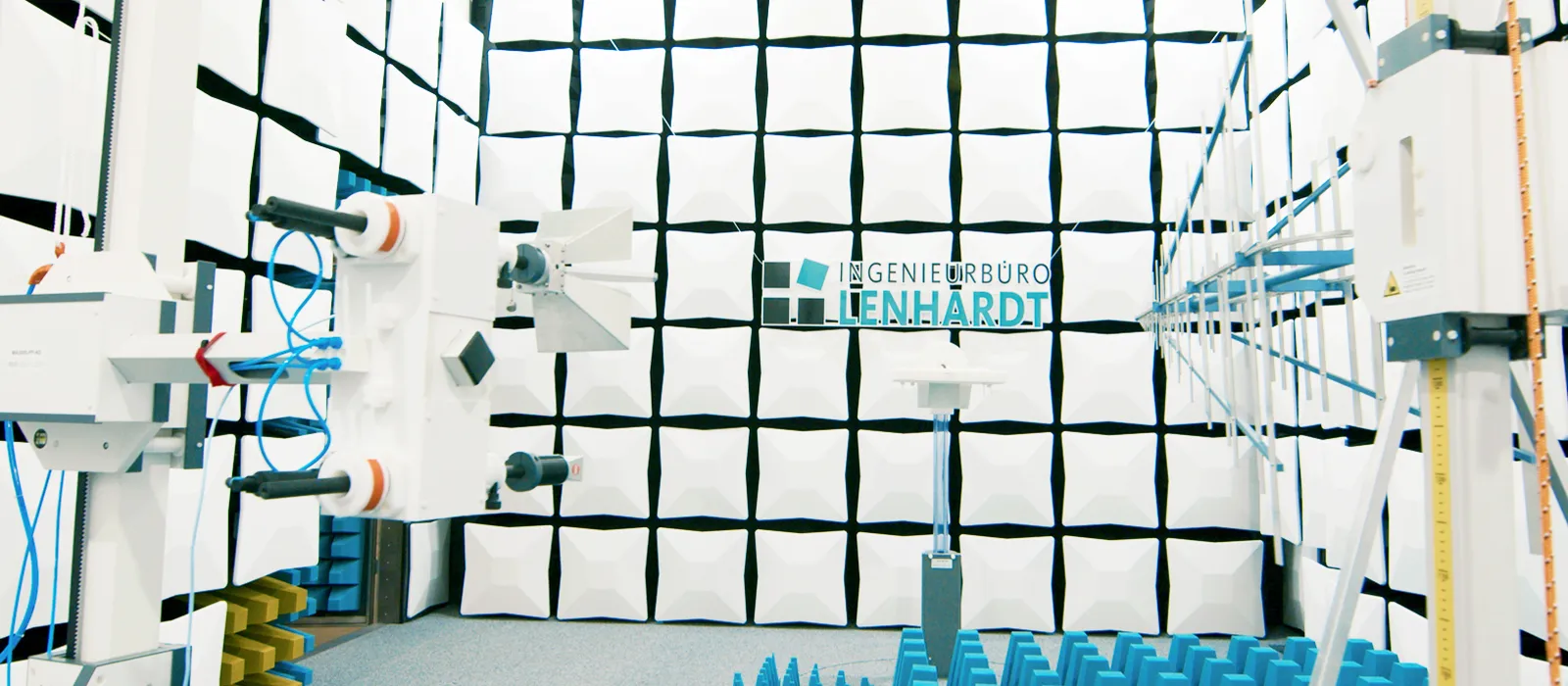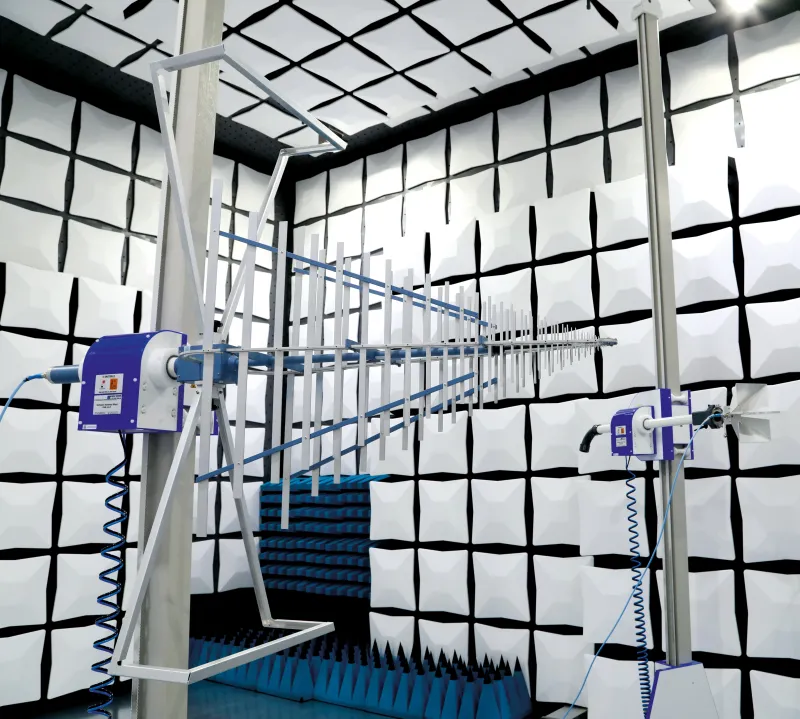
EMC Testing
ISO/IEC 17025-accredited laboratory for electromagnetic compatibility.From pre-compliance testing to full certification – complete service for global market access.
Compliance for Your Products
IB-Lenhardt AG provides integrated EMC testing and certification — covering international approvals under CE (NB 2784), FCC (TCB), ISED Canada (FCB), and Japan MIC (RCB) to ensure compliance and efficient market access worldwide.
Automotive
Vehicle radar – Remote keys / Keyless systems – TPMS – Infotainment
Industrial
Industrial radar – Wireless M-Bus / CAN-Bus – RFID / NFC – UWB systems
Consumer Electronics
Entertainment devices – Wi-Fi – Bluetooth / Zigbee – Wireless HD
Defense
Radar systems – Military electronics – Control systems – Communication equipment
Importance of EMC Testing
Electromagnetic Compatibility (EMC) ensures that electronic devices operate reliably — without causing interference to other systems and without being affected by external electromagnetic disturbances.
Our ISO/IEC 17025–accredited EMC testing covers all relevant disciplines, from Electromagnetic Susceptibility (EMS) to Electromagnetic Interference (EMI), providing the basis for global market approval under CE, FCC, ISED, UN ECE R10, and other regulatory frameworks.
Immunity Testing
EMS / Electromagnetic Susceptibility
- Radiated immunity (EN 61000-4-3)
- Conducted immunity (EN 61000-4-6)
- Transient immunity: ESD, Burst, Surge (EN 61000-4-2/4/5)
Emission Testing
EMI / Electromagnetic Interference
- Radiated emissions (CISPR 32)
- Conducted emissions (CISPR 32)
Power Quality
Mains Harmonics & Voltage Fluctuations
- Harmonics (EN 61000-3-2)
- Voltage fluctuations / flicker (EN 61000-3-3)
Details on EMC standards and test requirements can be found in the corresponding section; technical explanations and definitions are provided in the FAQ section. For a comprehensive overview, see our EMC Compliance Guide.
The EMC Testing Process
From initial request to market approval — based on a structured process with accredited testing in accordance with ISO/IEC 17025.

DAkkS-Accredited EMC Test Laboratory
Benefit from the modern testing facilities of our laboratory, accredited by DAkkS according to ISO/IEC 17025.
2 fully anechoic chambers (3 m test distance)
2 semi-anechoic chambers (5 m test distance)
Shielded room for conducted measurements
Low-noise measuring receivers
Highly skilled staff with extensive experience
Our EMC tests use amplifiers and test systems from Rohde & Schwarz, Hilo, and Ametek CTS.
Let's get in Touch
The experts at IB-Lenhardt AG and IBL-Lab GmbH are always there for you. Just contact us!Wireless Charging in the EMC Laboratory
In our Insight Lab series, we demonstrate EMC testing of a wireless power transmitter under real operating conditions.
The field strength is measured at a 20 cm distance at 120 kHz, providing the basis for Qi and Qi2 conformity testing.
Key EMC Standards & Directives
European Union
-
2014/30/EU – EMC Directive
- Directive for electrical and electronic equipment without radio functionality.
-
2014/53/EU – Radio Equipment Directive (RED)
- EU directive for radio equipment covering safety, EMC, and efficient use of the radio spectrum.
-
ETSI EN 301 489 Series
- Harmonized EMC standards for radio equipment and radio communication services under the RED.
-
EN 55032
- Multimedia equipment – Limits and measurement methods for conducted and radiated emissions.
-
EN 55035
- Multimedia equipment – Immunity requirements and test procedures.
-
EN 61000-6-1
- Generic standard – Immunity for residential, commercial, and light industrial environments.
-
EN 61000-6-2
- Generic standard – Immunity for industrial environments.
International
-
IEC 61000-4-2 and following
- International basic standards defining EMC test methods for ESD, burst, surge, and immunity.
-
USA: FCC 47 CFR Part 15
- U.S. regulation for radio and digital devices specifying emission limits up to 40 GHz.
-
Canada: ISED ICES-003
- Canadian EMC requirements for information technology, audio, and multimedia equipment.
-
Japan: VCCI
- Voluntary EMC marking system for information technology and audiovisual equipment.
Automotive
-
UN/ECE Regulation No. 10
- International regulation defining EMC type approval for vehicles and electronic sub-assemblies (ESAs).
-
CISPR 25 / ISO 11452 Series
- Automotive standards specifying emission limits and immunity requirements for electrical and electronic components in vehicles.
Military and Defense
-
NATO AECTP-500
- NATO standard for electromagnetic and environmental testing under STANAG 4370, defining qualification procedures for land, sea, air, and space systems.
-
MIL-STD-461G
- U.S. Department of Defense standard for EMC testing of military systems, covering both emission and susceptibility requirements.
Pre-Compliance
EMC Testing During Development
Identify potential EMC issues early and optimize your design before formal certification begins.
Our accredited laboratories offer flexible testing capacities in 3 m and 5 m chambers — ideal for prototypes, assemblies, and pre-series products.
Your Benefits:
Early detection of EMC issues
Design optimization support
Flexible scheduling and test capacities
Direct expert assistance in the laboratory
Avoid redesigns and ensure a smooth transition to final certification.
Frequently Asked Questions
All you need to know about EMC testing
- What does EMC means?
-
Electromagnetic Compatibility (EMC) refers to the ability of an electrical or electronic device to operate as intended within its electromagnetic environment — without causing interference to other equipment and without being affected by external electromagnetic sources.
A product is considered electromagnetically compatible when it emits no excessive interference (EMI – Electromagnetic Interference) and is sufficiently resistant to external disturbances (EMS – Electromagnetic Susceptibility). - What do EMI and EMS stand for?
-
EMI (Electromagnetic Interference) describes unwanted electromagnetic emissions that can disrupt the operation of nearby equipment.
EMS (Electromagnetic Susceptibility) defines a device’s ability to maintain reliable operation when exposed to such disturbances.
Both are key performance parameters in EMC testing.
- Is EMC testing mandatory?
-
Yes. EMC testing is required for placing products on the EU market and forms an integral part of the CE marking process. Compliance is demonstrated through technical documentation and the EU Declaration of Conformity (DoC), confirming that the product meets all applicable directives.
- Which EMC standard applies to my product?
-
This depends on the product category, operating environment, and radio functionality — for example, EN 55032 / EN 55035 for multimedia devices, EN 61000-6-x for generic environments, or ETSI EN 301 489-xx for radio equipment.
Further details are available in the EMC Standards & Regulations section of this page.
- Do you offer pre-compliance testing during development?
-
Yes. IB-Lenhardt AG offers pre-compliance testing in 3 m / 5 m chambers to accelerate design iterations and minimize certification risks.
These tests are part of our development-support services — see the Pre-Compliance section for more information.
Six Reasons Why EMC Compliance Testing Matters
Proper Function
EMC testing ensures that your product performs as intended and remains unaffected by external electromagnetic fields.Cost Efficiency
Thorough EMC validation reduces the likelihood of technical support cases, warranty claims, and costly rework or maintenance.Regulatory Compliance
EMC testing verifies that your product meets mandatory legal and regulatory requirements imposed by authorities worldwide.Market Access
To enter global markets, electronic devices must comply with applicable emission and immunity limits defined by international standards.Reliability
Compliance with EMC requirements enhances device lifespan and overall operational reliability.Customer Confidence
Comprehensive EMC testing strengthens customer trust and supports a positive brand reputation.
EMC Standards

Contact
EMC Testing Tailored to Your Requirements
Our EMC testing services form the basis for CE, RED, FCC, ISED, and other international market approvals. From technical consulting and test reporting to final certification, you benefit from the expertise of our experienced engineers.
Have specific requirements? We provide customized testing solutions and support your product development with pre-compliance and design-validation testing.